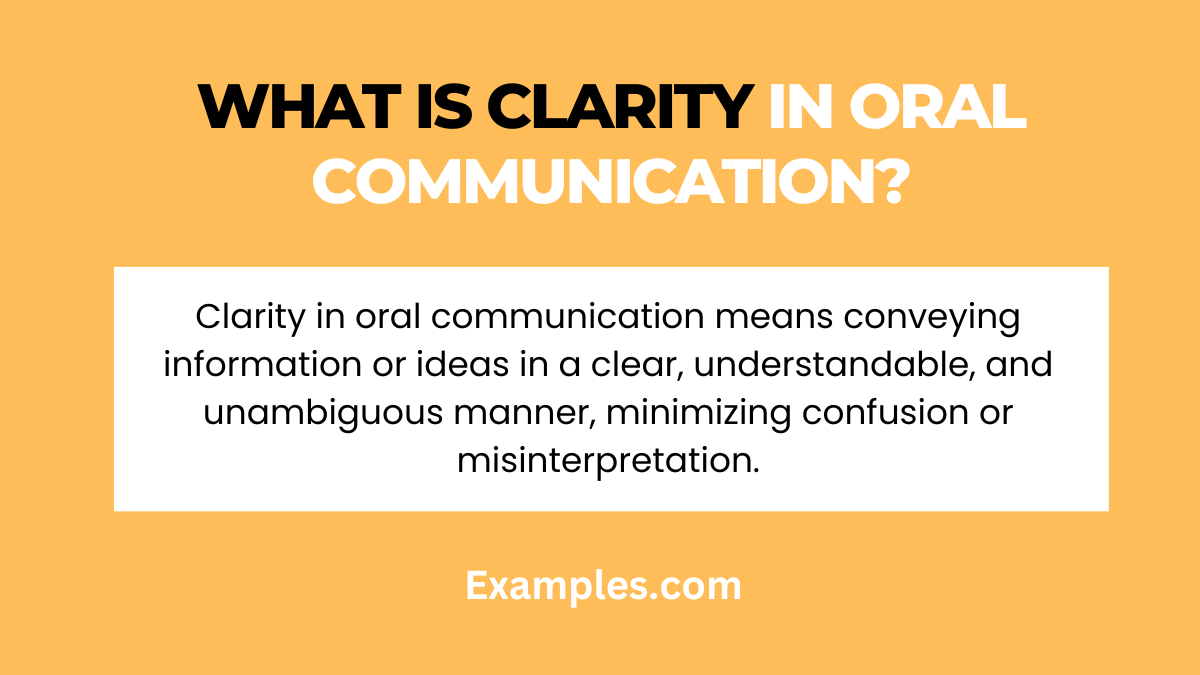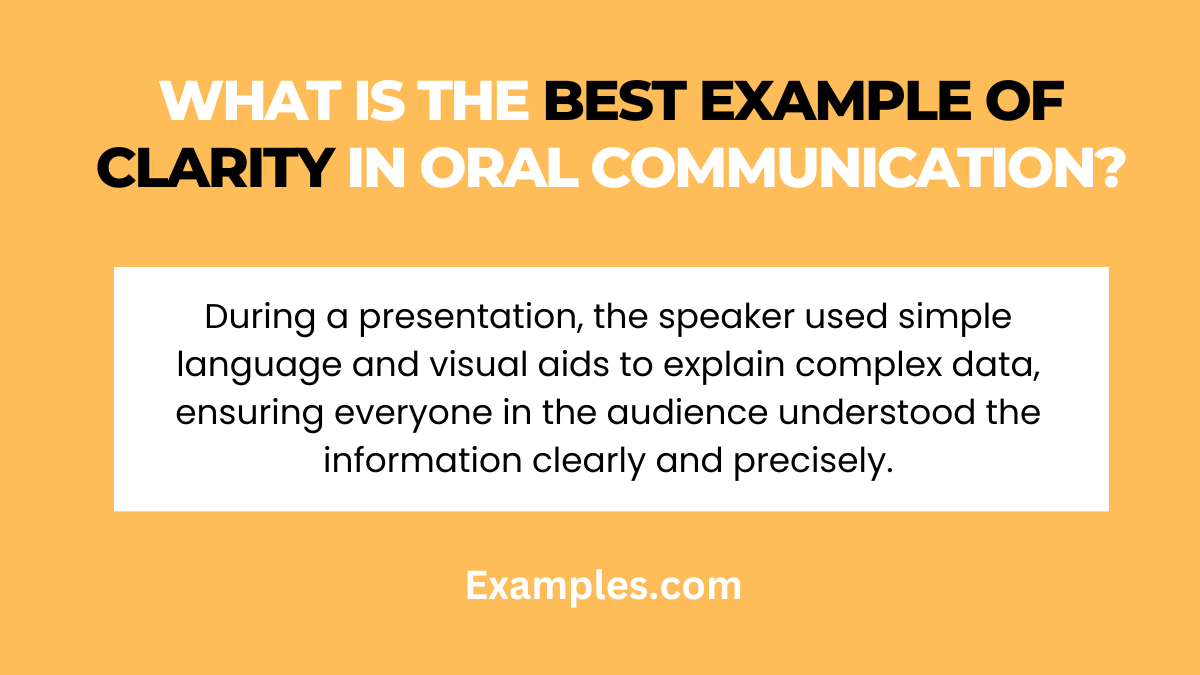19+ Clarity in Oral Communication Examples
In the realm of effective communication, the concept of Clarity in Oral Communication stands paramount. This comprehensive guide dives into the nuances of clear and concise verbal expression, an essential skill in personal and professional contexts. Understanding and mastering this skill ensures that your message is not just heard but understood and acted upon. We’ll explore its importance, practical tips, and real-world examples, making it an indispensable resource for anyone looking to refine their communication prowess.
What is Clarity in Oral Communication?

Clarity in Oral Communication refers to the straightforwardness and simplicity in speech that ensures the listener understands the message as intended. It involves using precise words, avoiding jargon, and structuring sentences and ideas logically. This clarity is vital in eliminating misunderstandings and ensuring efficient and effective communication.
What is the Best Example of Clarity in Oral Communication?

One of the best examples of Clarity in Oral Communication can be seen in public speaking, where speakers use clear, direct language to convey their message. A TED Talk, for instance, often showcases this clarity. The speaker selects words carefully, uses a logical flow of ideas, and emphasizes key points, making complex topics accessible to a broad audience.
20 Examples of Clarity in Oral Communication?
Clarity in oral communication is pivotal for effective exchange of ideas and information. It involves articulating thoughts in a straightforward and understandable manner. Emphasizing active listening in oral communication and knowing your audience helps ensure that the message is not only conveyed but also comprehended accurately. Achieving clarity can significantly enhance interpersonal relationships and professional interactions.
- “Please turn off your phones during the meeting.” – A clear, direct request avoids misunderstandings in a professional setting.
- “I need the report by next Monday, without fail.” – Specifying deadlines clearly ensures timely completion of tasks.
- “Let’s meet at 10 AM in the conference room.” – Clarity in scheduling prevents confusion about time and place.
- “I prefer email updates over phone calls for this project.” – Stating communication preferences clearly helps streamline interactions.
- “Could you elaborate on that point?” – Asking for clarification fosters understanding in conversations.
- “My main concern is the project’s budget.” – Highlighting the primary issue aids in focused discussions.
- “I enjoyed your presentation, especially the innovative solutions.” – Specific feedback encourages and guides the receiver.
- “I’m not sure I follow; could you rephrase that?” – Seeking clarity improves mutual understanding.
- “Let’s summarize to ensure we’re on the same page.” – Summarizing key points reinforces understanding.
- “I disagree with that approach because…” – Articulating reasons for disagreement fosters constructive debate.
- “Please call me if you have any questions.” – Offering availability for clarification builds trust.
- “The main goal of our project is to increase efficiency.” – Stating objectives clearly aligns team efforts.
- “We will postpone the meeting until further notice.” – Clear instructions avoid scheduling conflicts.
- “This procedure requires your utmost attention.” – Emphasizing importance clarifies priorities.
- “Remember, safety is our primary concern.” – Reiterating key values reinforces their importance.
- “I’m available for a chat anytime this week after 2 PM.” – Providing specific availability eases scheduling.
- “Could you walk me through the process step by step?” – Requesting detailed explanations enhances comprehension.
- “I’m confident this strategy will work because…” – Backing statements with reasons enhances persuasiveness.
- “In conclusion, our plan will benefit us in these ways…” – Summing up with key benefits reinforces the message.
- “Let’s ensure everyone understands the task at hand.” – Checking for comprehension confirms effective communication.
Importance of Clarity in Oral Communication

- Enhances Understanding: Clarity in oral communication ensures that the message is understood as intended, reducing misunderstandings.
- Efficient Information Exchange: Clear communication facilitates quicker and more effective information exchange.
- Builds Credibility: Speaking clearly and concisely establishes the speaker’s credibility and professionalism.
- Improves Engagement: Clear communication keeps the audience engaged and interested in the conversation.
- Facilitates Decision Making: When information is communicated clearly, it aids in more informed and effective decision-making.
How to Communicate with Clarity in Oral Communication?
- Be Concise in Oral Communication: Avoid overloading your audience with unnecessary information. Keep your message brief and to the point.
- Speak Clearly in Oral Communication: Enunciate your words and maintain a moderate pace to ensure your audience can easily follow along.
- Know Your Audience in Oral Communication: Tailor your message to the understanding and interests of your audience to ensure it resonates with them.
- Use Simple Language: Avoid jargon and complex language that might confuse your audience. Simplicity is key to clarity.
- Provide Examples and Analogies: Use relevant examples and analogies to illustrate your points more vividly and make them easier to understand.
The article on “Clarity in Oral Communication” from Examples.com emphasizes the importance of clear and concise verbal expression in both personal and professional contexts. It provides practical tips and real-world examples to help the reader understand and master the art of delivering messages clearly and effectively. The guide explores the concept of clarity, its importance in reducing misunderstandings, and how to achieve it through simple language, concise messaging, and understanding the audience.
In conclusion, clarity in oral communication is a fundamental skill that enhances understanding, credibility, and engagement in conversations. For further reading on improving communication skills, especially in professional environments, resources from Harvard Business Review offer invaluable insights. Additionally, exploring the psychological aspects of communication can be beneficial, as seen in articles from Psychology Today. These external resources complement the understanding of clarity in oral communication, providing broader perspectives on effective verbal interaction.



